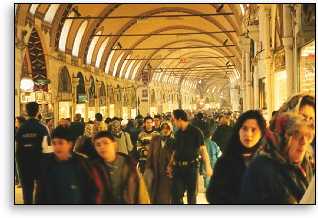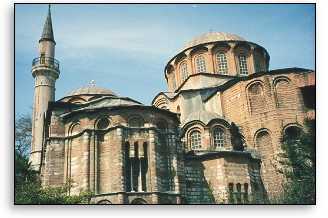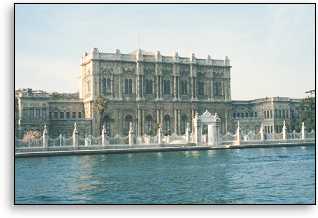Covered Bazaar, Chora Church, New Istanbul, Hotel Pera Palas, Bosphorus Cruise
Western Turkey - Group Journal
Day 3 -
Monday, 6 April 1998, Istanbul
by Janie & Rufus Littlefield
Istanbul, Bosphorus Cruise and the "Midnight Express" to Ankara
We awoke with the city at 5:30 a.m. as the early morning call to prayer echoed across the hills and down through the cobbled streets of our neighborhood. I could almost hear a collective sigh and groan as our group rolled over in their beds for another hour's sleep. This is our last day in Istanbul, and there's much to do before we go.
We loaded our bags into a van in front of Hotel Ayasofya and waved a fond farewell to our wonderful hosts. They had treated us well, caring for us as family with lovely clean rooms and plentiful and tasty breakfasts. Mama's bundt cake was a delicious added treat this morning.

At 9 a.m. our bus departed for the covered bazaar. We were among the first to arrive and fortunately the bazaar was not crowded yet. Meli directed us how to go and turned us loose to shop on our own for an hour. When we gathered together at 10:00, many rustling packages were opened for show and tell. Among the purchases were a leather jacket and vest, an ikat-striped caftan, a dagger, tee-shirts, an alabaster egg, and a Turkish flag.
Our next stop was Chora Church (pronounced Cora). Chora means 'out in the countryside' or out in the womb of nature. Chora is also used to refer to Jesus in the womb of Mary. The frescos and mosaics are used not only for their visual beauty, but also for teaching. They are charismatic depictions of culture and history. In the mosaics we saw Jesus depicted in several forms - as creator, as teacher, as son and as savior.

In one of the mosaics, the emperor depicted himself, in his crown, at the foot of Christ (though he was much smaller in size) to show that it was he who built the church and made it all possible. When we saw the restored mosaics, however, the emperor had instead been replaced by the turban-clad restorer. He was showing his preference for his own culture (hence the turban) to that of the emperor.
Meli described each picture in detail and helped us to see much more than was at first the obvious. Her favorite fresco depicts Jesus above the broken locks of the gates of hell, on the one side saving Adam and on the other, Eve. She asked us to remember the different ways saints were shown - the religious, the pillar, and the soldier saints.
On our bus once again, we drove along the Golden Horn and crossed to the newer part of the city to walk the pedestrian mall and find lunch on our own. We gathered a couple of hours later at the Hotel Pera Palas, where Agatha Christie lived while writing Murder on the Orient Express. We saw her room, but were more impressed with Ataturk's suite. In it hung a large tapestry with 5-toed dragons in its border, symbolizing great honor and importance -- a gift from China. Also, there was a woven and embroidered piece which incorporated a clock set at 9:05, the exact time of Ataturk's death, and elephants to signify November, and 10 candle cups to show the tenth of the month, thus November 10th at 9:05. The mystery of it is this: The entire piece was made 12 years before Ataturk died of cirrhosis of the liver!
Next stop, the spice market. Eleven of us chose to avoid the sea of humanity swarming at its gate. Instead we boarded the "Florya" to relax and wait for our cruise to the Bosphorus.

Dolmabache Palace
We sailed just before 5 p.m. on calm seas, along the shoreline, passing the fabulous Dolmabache Palace where Ataturk died in 1938. We entered the Bosphorus from the Golden Horn and crossed to the Asia Minor side, giving a full view of the Bosphorus Expansion Bridge. We were told that the top layer of the Bosphorus has a stronger current and the water flows out to the Sea of Marmara. The deeper, more saline water flows into the Black Sea. We cruised past the summer palace, and saw the summer homes of the wealthy who live here only 1 to 3 months of the year. These homes are valued around $20 million! There was a castle and fortress (built in the 1500's) on the European side, while on Asia Minor was a turreted fortress built in the late 1300's. With the two fortresses complete, communication along the Bosphorus was brought to a standstill, leaving the Byzantine capital completely cut off to the north.
A brief stop on the European side allowed us to stretch our legs, drink tea and watch Meli beat Mahmut at backgammon.
Dinner back in Asia Minor was interesting and a bit adventurous. Starters were a vegetable plate of steamed artichoke, carrot, zucchini and onion. The main course was rice with "the thigh of a woman," and a parchment-wrapped vegetable and meat dish. Our dessert was a challenge for some - a pumpkin and syrup offering with a nice little cream-stuffed apricot.
We raced for the bus and proceeded to our train, the Ankara Express. We crammed (just as we've seen sardines do in little tin cans) into our tiny sleeping compartments where only one could stand at a time. After finally figuring out how to turn two upholstered chairs into bunk beds, we threw open the window for air, only to find it increased the bunk space tremendously. Rufe found it gave him much more room for his 6'6" frame to stick his feet out the window from his upper bunk. When we considered the nearness of other trains and the possibility of tunnels, however, he thought better of the idea and pulled them in. Tonight will be a night to to remember - hope you all slept well and had wonderful dreams!